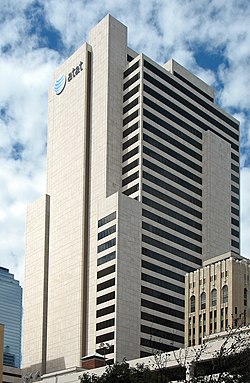 Logo used since 2016 | |
 Whitacre Tower, AT&T's corporate headquarters in Dallas | |
| Formerly |
|
|---|---|
| Company type | Public |
| ISIN | US00206R1023 |
| Industry | |
| Predecessors |
|
| Founded | October 5, 1983 [2] |
| Headquarters | Whitacre Tower, , United States |
Area served | United States |
Key people | |
| Products | |
| Revenue | |
| Total assets | |
| Total equity | |
Number of employees | 140,990 (2024) |
| Divisions | |
| Subsidiaries | Cricket Wireless |
| ASN | |
| Website | att.com |
| Footnotes /references Financials as of fiscal year endedDecember 31,2024 [update] . References: [3] | |
AT&T Inc., an abbreviation of its predecessor's former name, the American Telephone and Telegraph Company, is an American multinational telecommunications holding company headquartered at Whitacre Tower in Downtown Dallas, Texas. [4] It is the world's third largest telecommunications company by revenue and the third largest wireless carrier in the United States behind T-Mobile and Verizon. [5] As of 2023, AT&T was ranked 32nd on the Fortune 500 rankings of the largest United States corporations, with revenues of $122.4 billion. [3]
Contents
- History
- Origin and growth (1877–1981)
- Breakup and reformation (1982–2004)
- Purchase of former parent and acquisitions (2005–2013)
- Recent developments (2013–present)
- Landline operating companies
- Baby Bells chart
- Current states
- Former operating companies
- Decline of rural landlines
- Corporate structure
- Facilities and regions
- Corporate governance
- Political involvement
- Historical financial performance
- Carbon footprint
- Criticism and controversies
- Hemisphere database
- Censorship
- Privacy controversy
- Copyright enforcement
- Discrimination against local public-access television channels
- Information security
- Accusations of enabling fraud
- Aaron Slator controversy
- Overcharging government agencies
- One America News Network
- Leaking data to Wall Street
- Bribery to influence legislation
- 2024 outage
- Naming rights and sponsorships
- Buildings
- Venues
- Sponsorships
- See also
- References
- External links
The modern company claims the history of the original AT&T founded in 1885 and all relevant history is found on the company's website. The company to bear the AT&T name began as a merger of the SBC Corporation (an original Baby Bell) and AT&T Corporation (Ma Bell). SBC began its history as the American District Telegraph Company, formed in St. Louis in 1878. [6] After expanding services to Arkansas, Kansas, Oklahoma and Texas through a series of mergers, it became the Southwestern Bell Telephone Company in 1920. [7] Southwestern Bell was a subsidiary of the original American Telephone & Telegraph Company, itself founded in 1885 as a subsidiary of the original Bell Telephone Company founded by Alexander Graham Bell in 1877. [8] [9] [10] In 1899, AT&T became the parent company after the American Bell Telephone Company sold its assets to its subsidiary. [11] During most of the 20th century, AT&T had a near monopoly on phone service in the United States through its Bell System of local operating companies. This led to AT&T's common nickname of "Ma Bell". The company was formally rebranded as AT&T Corporation in 1994. [12]
The 1982 Modification of Final Judgment concluded the 1949 anti-trust lawsuit United States vs. Western Electric Company and American Telephone and Telegraph Company, and resulted in the breakup of the Bell System, in which AT&T divested ownership of its local operating subsidiaries. [13] The regional operating companies were reorganized in seven Regional Bell Operating Companies (RBOCs), commonly called "Baby Bells", including Southwestern Bell Corporation (SBC). [13] The latter changed its name to SBC Communications Inc. in 1995. [14] SBC acquired fellow Baby Bells Pacific Telesis in 1997 and Ameritech in 1999. [15]
In 2005, SBC purchased its former parent AT&T Corp. and took on the latter's branding, history, and stock trading symbol, as well as a version of its iconic logo. The merged entity, naming itself AT&T Inc., launched on December 30, 2005. [16] The newly merged and renamed AT&T Inc. acquired BellSouth Corporation in 2006, the last independent Baby Bell, making the two companies' joint venture Cingular Wireless (which had itself acquired AT&T Wireless in 2004) a wholly owned subsidiary of AT&T Inc. Cingular was then rebranded as AT&T Mobility.
AT&T Inc. also acquired Time Warner, [17] [18] with the proposed merger confirmed on June 12, 2018 [19] and the aim of making AT&T Inc. the largest and controlling shareholder of Time Warner, which it then rebranded as WarnerMedia in 2018. The company later withdrew its equity stake in WarnerMedia in 2022 and merged it with Discovery, Inc. to create Warner Bros. Discovery, divesting itself of its media arm.
Today's AT&T reconstitutes most of the former Bell System, and includes four of the seven "Baby Bells" along with the original American Telephone and Telegraph Company, including the long-distance division. [15]



